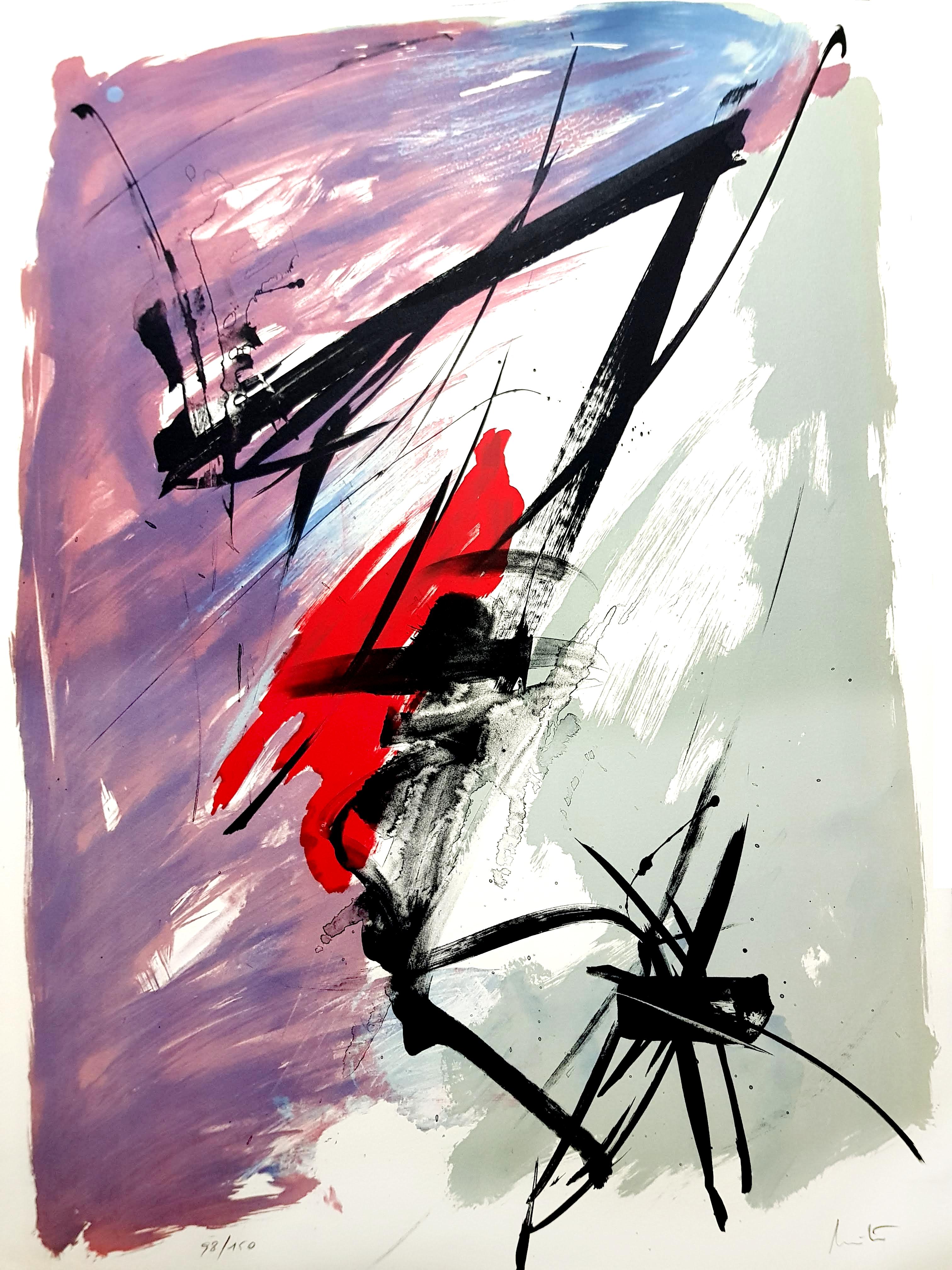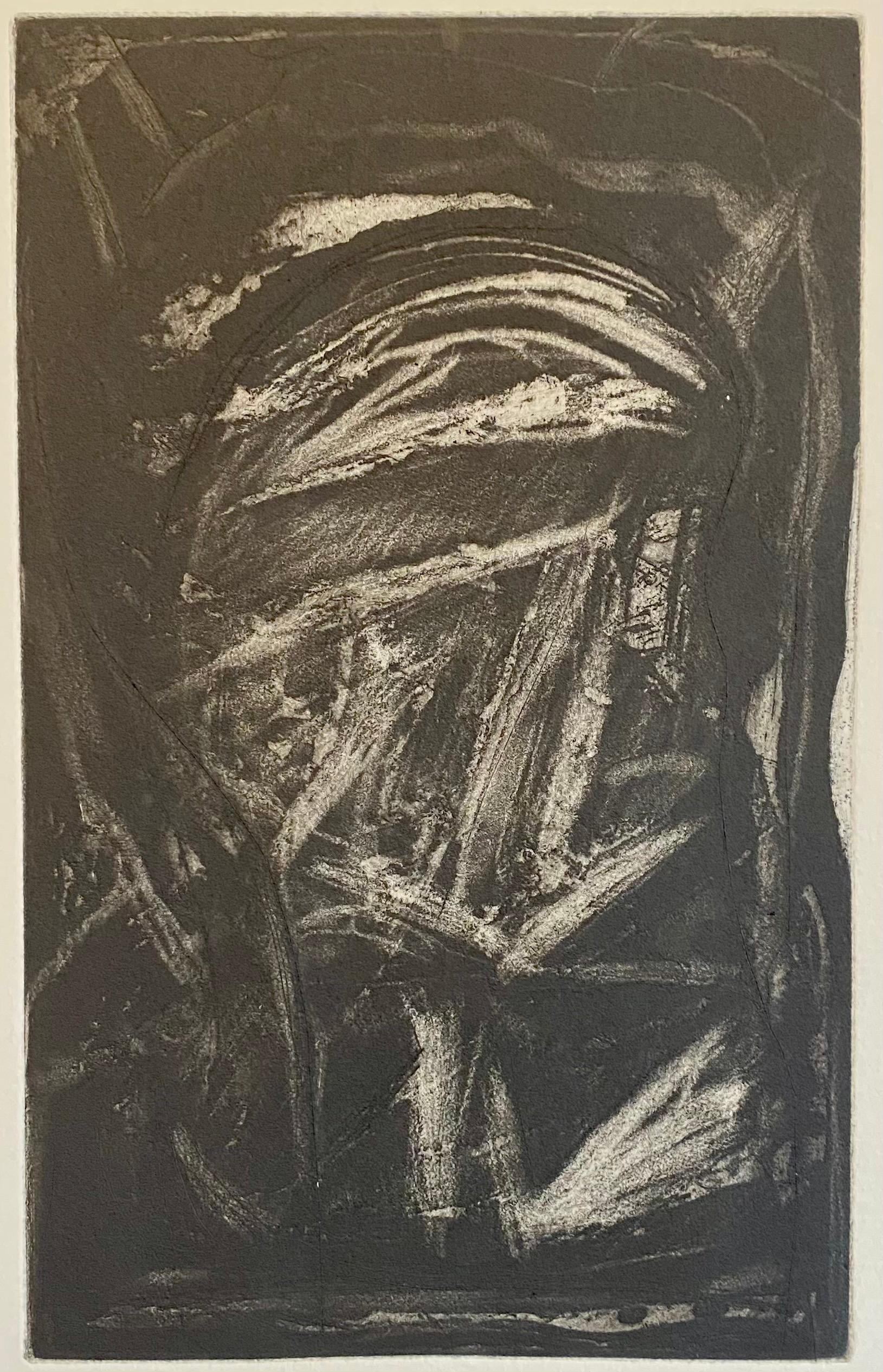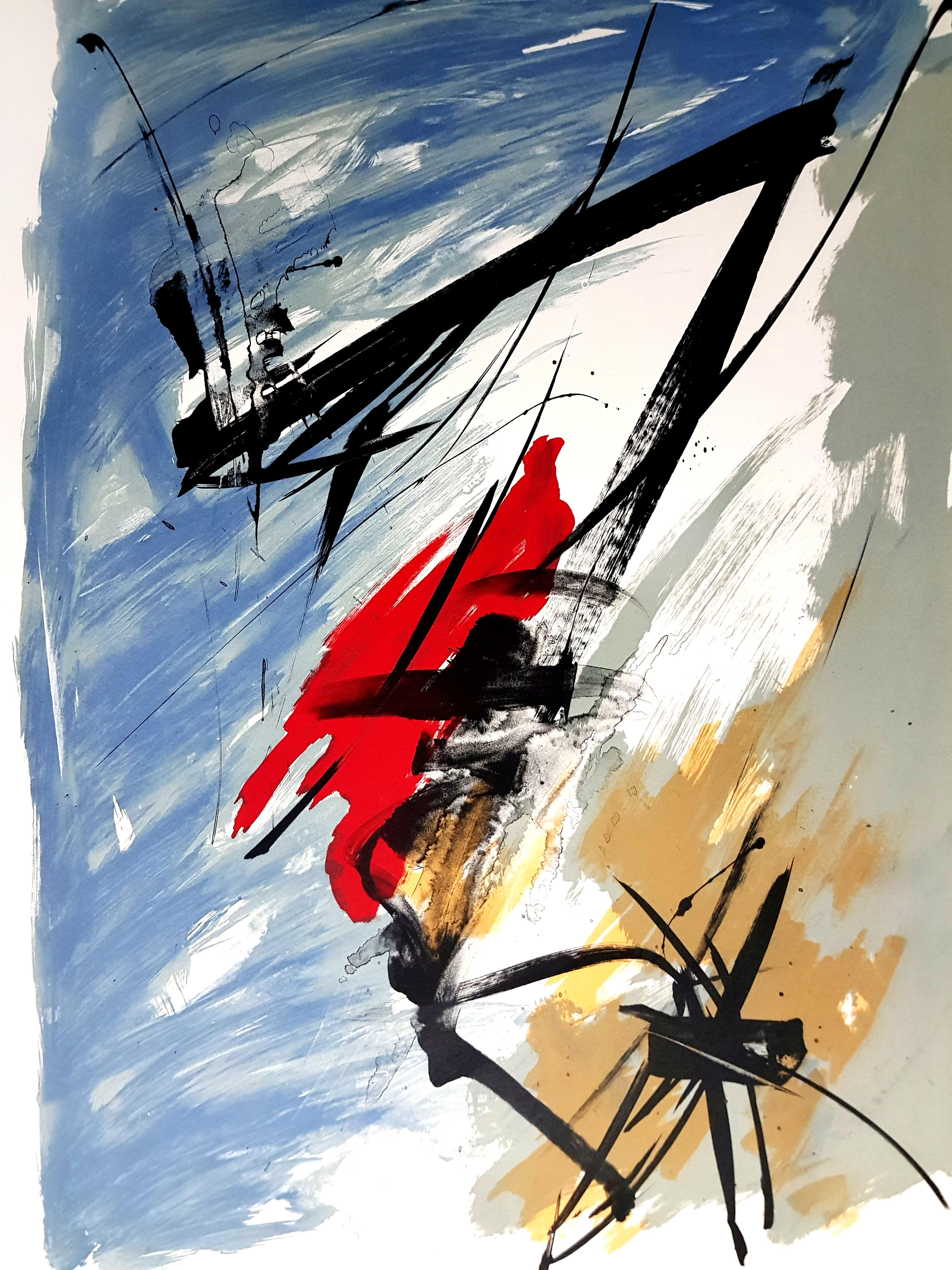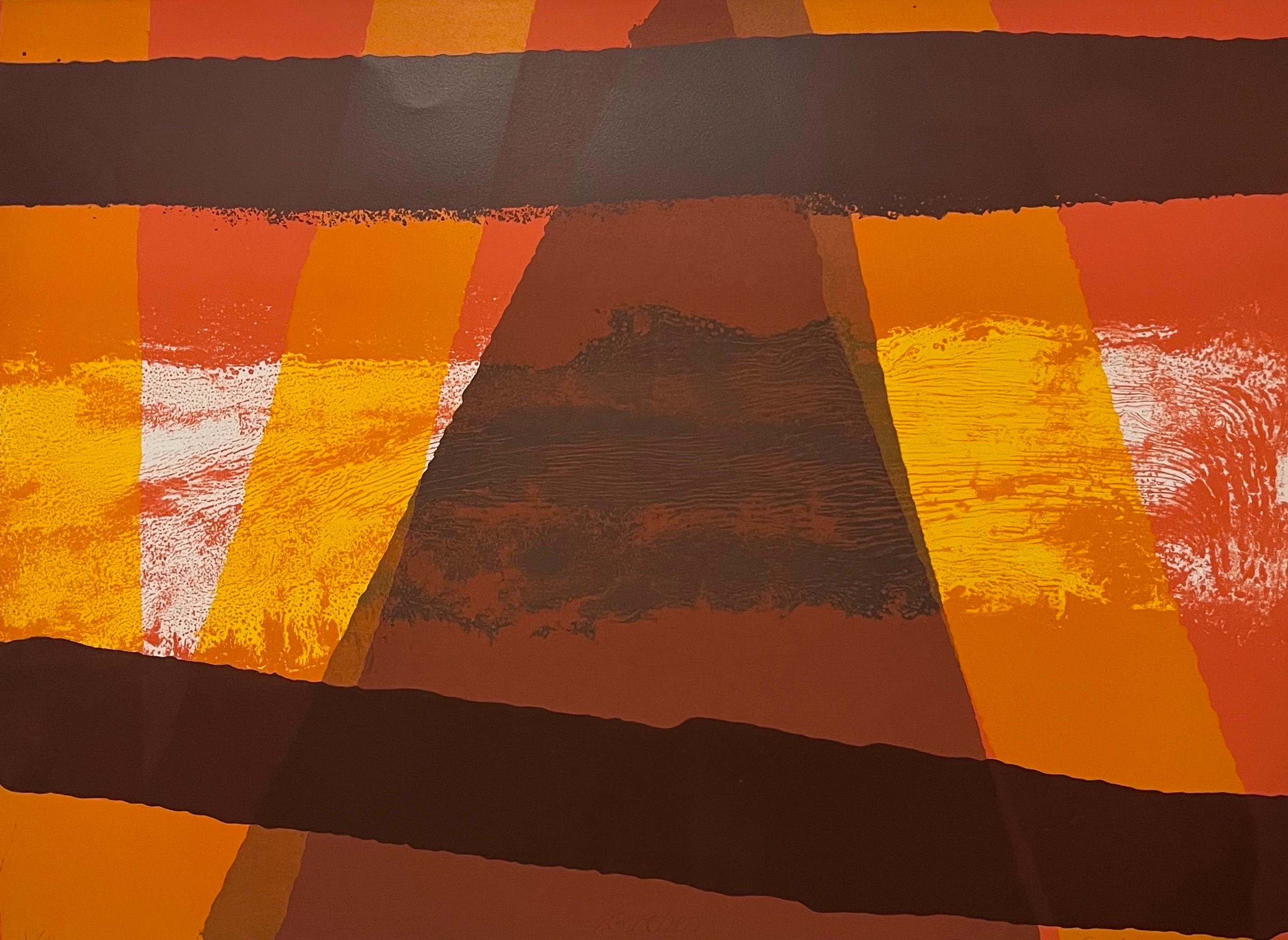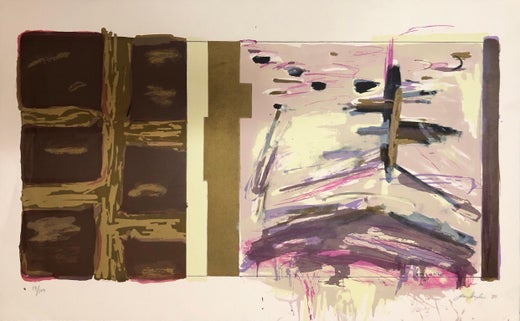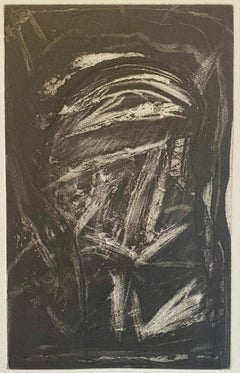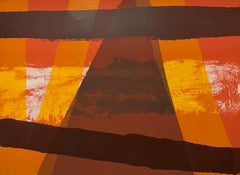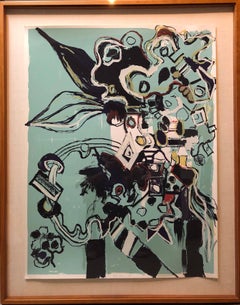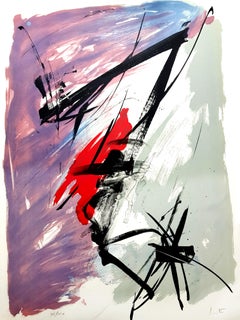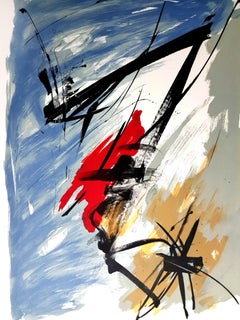Items Similar to Large Abstract Expressionist Feminist Lithograph Incorporating Text ''FMSWNL''
Want more images or videos?
Request additional images or videos from the seller
1 of 8
Joan SnyderLarge Abstract Expressionist Feminist Lithograph Incorporating Text ''FMSWNL''1980
1980
$1,600
£1,209.98
€1,385.97
CA$2,241.98
A$2,447.49
CHF 1,288.64
MX$29,318.12
NOK 16,481.17
SEK 15,047.58
DKK 10,353.49
About the Item
''FMSWNL'' from the limited edition of 100. Pencil hand signed and dated.
Joan Snyder, (born April 16, 1940), is an American painter from New York. She is a MacArthur Fellow, a Guggenheim Fellow, and a National Endowment for the Arts Fellow.
Snyder first gained public attention in the early 1970s with her gestural and elegant "stroke paintings," which used the grid to deconstruct and retell the story of abstract painting. By the late seventies, Snyder had abandoned the formality of the grid. She began more explicitly incorporating symbols and text, as the paintings took on a more complex materiality. These early works were included in the 1973 and 1981 Whitney Biennials and the 1975 Corcoran Biennial.
"The functions of Ms. Snyder's art, first and foremost, are to further the tradition of painting and to explore the most serious aspects of the human condition; to connect us not only to one another and to nature but to ancient rites and myths. She reminds us that no matter how modern and civilized we are, art can still be raw, primitive and talismanic. Without apologies or decorum, Ms. Snyder's work awakens all of the things still wild within us." – Lance Esplund, WSJ
Often referred to as an autobiographical or confessional artist, Snyder's paintings are narratives of both personal and communal experiences. Through a fiercely individual approach and persistent experimentation with technique and materials, Snyder has extended the expressive potential of abstract painting, inspiring generations of emerging artists.
Honors and fellowships
Snyder is the recipient of a 1974 National Endowment for the Arts Fellowship, a 1983 John Simon Guggenheim Memorial Fellowship, a 2007 MacArthur Fellowship, and a 2016 Arts & Letters Award in Art from the American Academy of Arts & Letters.
In 1969 Snyder married photographer Larry Fink.
Snyder currently lives and works in Brooklyn and Woodstock, NY. She is represented by Franklin Parrasch Gallery in New York, NY, Parrasch Heijnen Gallery in Los Angeles, CA, and Elena Zang Gallery in Woodstock, NY.
Education
After graduating from Douglass College in 1962 with a BA in Sociology, Snyder received her MFA from Rutgers University in 1966.
While living on a New Jersey farm in 1962, Snyder worked in a studio on the Raritan River in New Brunswick, creating some of her earliest paintings of farm and landscape scenes, as well as expressionist portraits. In the mid to late 60's she was working explicitly with the idea of female sensibility, using materials in her paintings such as lentil seeds, flocking, thread, glitter and gauze. Snyder worked alongside artists such as Mary Heilmann, Jennifer Bartlett and Harriet Korman during the 1960s, all of whom were attempting to bring more process into their art making.
In the early 1970's Snyder began to explore paint as subject, reconstructing abstract painting through gestural strokes on canvas over a gridded background. These paintings, more commonly known as her 'stroke' paintings, were included in the 1973 and 1981 Whitney Biennials as well as the Corcoran Biennial in 1975. Following the stroke paintings in the mid 70s, Snyder's work once again revisited female sensibility and the work more vigorously explored materiality. By the late 70s she abandoned the formality of the grid and began to more explicitly incorporate symbols and text in her paintings. Snyder is a self proclaimed feminist and creates work in the vain of abstract expressionism because of how that genre of painting is over dominated by male artists. Within the work she uses shapes and marks that evoke female anatomy such as vaginal openings, nipples and breasts. She became a contributing member of Heresies, a Feminist Publication On Art and Politics, alongside artists and critics including Ida Applebroog, Joyce Kozloff, Lucy Lippard, Nina Yankowitz, Joan Braderman, Sue Heinemann and Miriam Schapiro, among many others.
Exhibitions and Collections
In 1994, Joan Snyder, Painter: 1969 to Now was displayed at Parrish Art Museum in Southampton, L.I. It was an exhibition made up of the first 25 years of her life's work up until that point in her career.
In 2005, The Jewish Museum in New York City presented a 35-year survey of Snyder's work that traveled to the Danforth Museum of Art in Framingham, Massachusetts. The exhibition was accompanied by a monograph, Joan Snyder, with an introduction by Norman Kleeblatt and essays by Hayden Herrera and Jenni Sorkin.
In 2011, Dancing With The Dark: Joan Snyder Prints 1963-2010 opened at the Zimmerli Art Museum at Rutgers University, New Brunswick, NJ, and traveled to Boston University Art Gallery, Boston, MA; University of Richmond Museums, Richmond, VA; University of New Mexico Art Museum, Albuquerque, NM accompanied by a comprehensive exhibition catalogue with an essay by the curator, Marilyn Symmes.
In 2015, Sub Rosa opened at Franklin Parrasch Gallery in Manhattan NY, which was an exhibition of the work she had been making the two years prior to the exhibition.
Snyder's work can be found in many public collections including The Metropolitan Museum of Art, The Museum of Modern Art, The Whitney Museum of American Art, The Jewish Museum, The Guggenheim, The High Museum of Art, The San Francisco Museum of Modern Art, Art Institute of Chicago, The Phillips Collection, The Dallas Museum of Fine Art and The National Museum of Women in the Arts.
- Creator:Joan Snyder (1940, American)
- Creation Year:1980
- Dimensions:Height: 23 in (58.42 cm)Width: 36.75 in (93.35 cm)
- Medium:
- Movement & Style:
- Period:
- Condition:minor wear.
- Gallery Location:Surfside, FL
- Reference Number:1stDibs: LU38212520022
Joan Snyder
Joan Snyder (b. 1940) is a pivotal American artist known for deeply expressive abstract paintings infused with personal narrative and feminist themes. Snyder’s distinctive "stroke" paintings utilize vibrant color, gestural brushwork, and innovative materials, challenging traditional artistic boundaries. Honored with a MacArthur Fellowship in 2007, her notable exhibitions include the Whitney Biennial and a comprehensive survey at The Jewish Museum. Her works are in the collections of MoMA, the Metropolitan Museum of Art, Whitney Museum of American Art, Solomon R. Guggenheim Museum, and The Jewish Museum.
About the Seller
4.9
Platinum Seller
Premium sellers with a 4.7+ rating and 24-hour response times
Established in 1995
1stDibs seller since 2014
1,846 sales on 1stDibs
Typical response time: 1 hour
- ShippingRetrieving quote...Shipping from: Surfside, FL
- Return Policy
More From This Seller
View AllAmerican Abstract Expressionist Artist Melissa Meyer Aquatint Etching
By Melissa Meyer
Located in Surfside, FL
Melissa Meyer (American, b. 1946)
1984-1987, aquatint etching in black on wove paper, hand signed print, dated, and numbered from small edition of 10.
Unframed. size: 9.75'' x 6'',...
Category
1980s Abstract Expressionist Prints and Multiples
Materials
Etching, Aquatint
Mod Abstract Expressionist Modernist Lithograph Edward Avedisian Color Field Art
By Edward Avedisian
Located in Surfside, FL
Edward Avedisian (1936-2007)
Cleo, Fur Queen, 1969
Lithograph in color on Arches wove paper.
Hand signed, dated and numbered in pencil.
Edition 100
Dimensions:
22.25 inches X 30.25...
Category
1960s Abstract Expressionist Abstract Prints
Materials
Lithograph
American Abstract Expressionist Artist Melissa Meyer Aquatint Etching
By Melissa Meyer
Located in Surfside, FL
Melissa Meyer (American, b. 1946)
1984-1987, aquatint etching in black on wove paper, hand signed print, dated, and numbered from small edition of 10.
Unframed. size: 9.75'' x 6'', 2...
Category
1980s Abstract Expressionist Prints and Multiples
Materials
Etching, Aquatint
Large Format Modernist Abstract Lithograph Silkscreen Print Woman Artist
By Lydia Dona
Located in Surfside, FL
1982-84 Hunter College, New York (M.F.A.)
1978-80 School of Visual Arts, New York
1973-77 Bezalel Academy of Art, Jerusalem (B.F.A.)
American, born in Romania
Lives and works in New York City
Solo Exhibitions
2008 Michael Steinberg Fine Art, New York
2006 Galeria Joan Prats, Barcelona
2005 Karpio + Facchini Gallery, Miami
Jacob Karpio Galeria, San Jose (Costa Rica)
2004 Michael Steinberg Fine Art, New York
2001 Marella Arte Contemporanea, Milan
2000 Von Lintel & Nusser, New York
Galerie Von Lintel & Nusser, Munich
1998 Galerie Thomas von Lintel, Munich
1997 Galerie des Archives, Paris
1995 Galerie Samuel Lallouz, Montreal
L.A. Louver, Los Angeles
1994 Marc Jancou Gallery, London
Galerie des Archives, Paris
1993 Galerie Barbara Farber, Amsterdam
Real Art Ways, Hartford (Connecticut)
1992 Tom Cugliani Gallery, New York
Galerie Marc Jancou, Zurich
Galerie des Archives, Paris
1989 Tom Cugliani Gallery, New York
Galerie Barbara Farber, Amsterdam
Studied at bezalel from 1973 to 1977. And it was a very fascinating time because it was a highly conceptually based school. Very much influenced by Joseph Beuys, and European Conceptualism, I didn’t really like the atmosphere there that much, because it was dominated by male painters like Jörg Immendorf, Marcus Lupertz, and a few others. then came to New York to study at SVA for two years. New York in 1978 was exciting. I was very lucky to be in a class that was full of very bubbly and very energetic artists like Keith Haring, Kenny Scharf, Tim Rollins, Moira Dryer, Frank Holliday, and Tom Cugliani (who later became one of my dealers).The eighties were dominated largely by Neo-Expressionist paintings. There were Germans, such as Baselitz, Kiefer, Richter, Penck, and the Italians, Clemente, Chia, Cucchi, Palladino as well as Schnabel, Fischl, Basquiat, Salle, and many others, but all of their paintings were figuratively based. But below the popular consent, there was a group of painters who were working more in the vein of what Stephen Westfall referred to as “Neo-Surrealism,” including George Condo, Jeffrey Wasserman, Kenneth Scharf, David Humphrey. However, I felt that Carroll Dunham and you were the only two painters who seemed to be less interested in the kind of narrative, lyrical, or let’s say, stationary composition. He belongs to the generation of Terry Winters, Elizabeth Murray, David Reed and Jonathan Lasker but in some strange way, if we’re looking back to the mid-eighties, we have to include New Image painters like Susan Rothenberg, Neil Jenney, and Robert Moskowitz who were working in between the figure and abstraction with a kind of condensation and compression, in relationship, lets say, to cartoon imagery. There are artists like Jeff Koons, or even Damien Hirst who took the Duchampian aspect and brought it into the continuity of his readymade. But for me, I see no difference between the crack in “Large Glass” and the drips in Jackson Pollock’s paintings. There was something that I felt in my own equation of the continuity between Paul Klee, Duchamp, Picabia, and, oddly enough, Clyfford Still.
What essentially is important is how different artists carry on a dialogue among themselves so that they can all keep their work vital. Whether from the abstract paintings of Richmond Burton, Fabian Marcaccio extending the borders of his paintings on to the wall, or Cady Noland’s early scattered installation, my own pre-occupation with machinery, urban environment, and the Duchampian models has always materialized in relationship to other forms of art making.
Selected Group Exhibitions:
2014 Drawing on Difference: An Ambition by Saul Ostrow and Lidija
Slavkovic, Studio Vendome Gallery, New York.
2013 Drawing on Habit: An Ambition by Saul Ostrow and Lidija Slavkovic,
South Carlton Beach and The Betsy-South Beach Exhibition Programs,
Art Basel, Miami Beach.
2013 Imprinted Pictures: Lydia Dona...
Category
1980s Abstract Expressionist Abstract Prints
Materials
Lithograph, Screen
Abstract Expressionist Modernist Colorful Bold Monoprint Monotype Painting Print
By Pierre Obando
Located in Surfside, FL
Pierre Andre Obando creates process oriented abstract paintings. He was born in Belize City, Belize and grew up in the Caribbean, the U.S. Virgin Islands, Miami, Fl and Jackson, MS.
...
Category
1990s Abstract Expressionist Abstract Prints
Materials
Monoprint, Monotype
Abstract Expressionist American Modernist Oil Monotype Monoprint Painting
By Larry Brown
Located in Surfside, FL
Larry Brown
Long-time established New York painter as well as faculty member the The Cooper Union, Brown works in oil on canvas and tempera paints on paper. He deals with themes of science and universality.
EDUCATION:
1970 M.F.A. in Painting, University of Arizona
1967 BA in Painting, Washington State University
SELECT GROUP EXHIBITIONS:
Mixed Company: Women Choose Men, AIR Gallery, New York, NY
Easy Breezy, Sears-Peyton Gallery, New York, NY
From Stone and Plate: Contemporary Prints from Tamarind Institute, California State University
Change of View Tamarind Institute Gallery, Albuquerque, NM
Animal As Muse, The Norton Museum of Art, W. Palm Beach, FL
Painting--Larry Brown, Joseph Haske, David Schoffman, Helander Gallery, New York, NY
Paper Houses, David Beitzel Gallery, New York, NY
Curators Choice, Albright-Knox Art Gallery, Buffalo, NY
Current Trends in Abstraction-- Larry Brown, Bill Drew...
Category
1980s Abstract Expressionist Abstract Paintings
Materials
Monoprint, Monotype
You May Also Like
Large Abstract Expressionist Lithograph by Louisa Chase
By Louisa Chase
Located in Long Island City, NY
Artist: Louisa Chase, American (1951 - 2016)
Title: Untitled (Spooks)
Year: 1987
Medium: Lithograph, signed and numbered in pencil
Edition: 30
Paper Size: 30 x 44.5 Inches (76.2 x 1...
Category
1980s Abstract Expressionist Abstract Prints
Materials
Lithograph
Untitled (from Ten Painters on War and Peace), hand signed lithograph
Located in Aventura, FL
Lithograph in colors on arches paper. Hand signed and numbered by Aviva Uri Edition 115/190.
From the "Ten Painters on War and Peace" portfolio. Printed...
Category
1970s Contemporary Abstract Prints
Materials
Paper, Lithograph
$375 Sale Price
25% Off
Jean Miotte - Abstract Composition - Original Signed Lithograph
By Jean Miotte
Located in Collonge Bellerive, Geneve, CH
Jean Miotte - Rare Original Signed Lithograph
Title: Abstract Composition
Dimensions: 76 x 56 cm
Edition: 98/150
Signed and Numbered in pencil
Jean Miotte, 1926 - 2016
Miotte came ...
Category
1970s Abstract Expressionist Abstract Prints
Materials
Aquatint
Jean Miotte - Abstract Composition - Original Aquatint Engraving
By Jean Miotte
Located in Collonge Bellerive, Geneve, CH
Jean Miotte - Rare Original Aquatint Engraving
Title: Abstract Composition
Dimensions: 76 x 56 cm
Jean Miotte, 1926 - 2016
Miotte came of artistic age in the decade after World War...
Category
1970s Abstract Expressionist Abstract Prints
Materials
Aquatint
Large Abstract Expressionist Etching with Chine Colle by Michael Steiner
By Michael Steiner
Located in Long Island City, NY
Abstract expressionist print by American artist Michael Steiner, who is most commonly known for his large scale sculptures.
Medium: Etching with chine colle...
Category
1980s Abstract Expressionist Abstract Prints
Materials
Etching
C.1950s Abstract Mid Century Lithograph
By Jerry Opper
Located in Arp, TX
From the estate of Jerry and Ruth Opper
Abstract Fireworks
1950's
Stone Lithograph on Paper
12.5" x 19", Unframed
Came from a portfolio of his work from his estate.
Jerry Opper (192...
Category
Mid-20th Century Abstract Abstract Prints
Materials
Stone
More Ways To Browse
Antique Prints Scottish Tartan
Blinky Palermo
Calder Sun
Debre Olivier
Deli Sacilotto
Exposition Vallauris
Helen Frankenthaler Signed
Joan Miro Lithograph Signed
Joan Miro Lithograph Volume 1
John Baldessari Signed
John Bolt
Moonlight Lithograph
Nude Descending A Staircase
Pace Gallery Columbus
Red Rider By Marino Marini
Salvador Dali Merchant Of Venice
Tony Caramanico Surf Journal
Warhol Electric Chair
